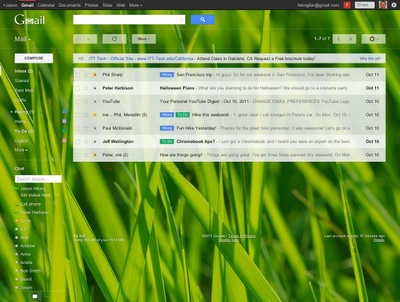 NEWS
NEWS
 NEWS
NEWS
 NEWS
NEWS
![]() Google is giving an in-depth look at its new design for GMail. The new highlights reflect the new demands of a data intensive, mobile community. Unfortunately, there is no mention of any improvements to its API, a glaring omission for an app that is increasingly in demand for sophisticated third party app and business uses.
Google is giving an in-depth look at its new design for GMail. The new highlights reflect the new demands of a data intensive, mobile community. Unfortunately, there is no mention of any improvements to its API, a glaring omission for an app that is increasingly in demand for sophisticated third party app and business uses.
Google gave a preview of GMail earlier this summer. Today, GMail is giving a more detailed look of its new design with particular attention to providing the capability for more streaming style conversations, new search functionality and automatic sizing to adjust the screen form factor depending on the device you are reading your email.
Google will make the new GMail available over the next few days as an option that people can turn on themselves.
![]() GMail has paid particular attention to its email thread through a redesign that as an example allows for you to see the profile picture of the people in the the thread. Do I need this if I use Rapportive?
GMail has paid particular attention to its email thread through a redesign that as an example allows for you to see the profile picture of the people in the the thread. Do I need this if I use Rapportive?
![]() Google calls its new sizing feature “elastic density,” which seems more like a fancy term for sizing according to your screen size. According to the Google Blog, “spacing between elements on the screen will automatically change based on the kind of display you’re using.” You may also change your density manually in the settings menu.
Google calls its new sizing feature “elastic density,” which seems more like a fancy term for sizing according to your screen size. According to the Google Blog, “spacing between elements on the screen will automatically change based on the kind of display you’re using.” You may also change your density manually in the settings menu.
Additional features include themes in HD and an improved UI for navigation with the ability to see labels and contacts at the same time. A new search feature has a drop-down menu for advanced search.
But where are the improvements to the API? Google has made little effort to update its API. developers have been forced to extract what they can to create their own APIs for integrating with GMail.
I covered this issue earlier in the year when writing for ReadWriteWeb. James Yu developed his own API for GMail. I wrote:
What we need, he says, is a robust and easy-to-use Javascript API for GMail that is shared across extensions and applications. He hopes developers will improve Gmailr, and over time, make it a robust API that developers find useful. He cites a few ways it can be improved:
- Expose methods that allow insertion of UI elements into various places in Gmail, like the sidebar.
- Improve the reliability of the API, taking into account the various weird states that Gmail can get into.
- Add capabilities to read the contents and metadata of emails received, sent, and interacted with.
Google is under increasing criticism for its decisions to scrap APIs for Google Reader, charge for access to the Google Apps API and its general seeming disregard for the platform community.
Google has a great product with GMail. It is the darling email app of the geek community. Gartner says it is ready for the enterprise. Often, though, it is the apps that make the product. That is the benefit of an API.
It also points to the issues Google Engineer Steve Yegge surfaced in his now famous rant. Klint Finley summed it up this way:
Google’s APIs have been a pain point for developers lately. In May Google shut down a number of APIs, leading some developers into the arms of Microsoft, which is offering professional support for some of its APIs such as the translation API. Gmail has been a real pain for developers to use a platform. So much so that one developer built an unofficial API. To be fair, Facebook has an API that’s been seen as one of the worst in the business, but it’s true – you can build businesses on Facebook. You can’t build a business on Google Plus.
We hope Google make a new unveiling soon. One that does not focus on a UI but instead a more simple and accessible API.
Support our mission to keep content open and free by engaging with theCUBE community. Join theCUBE’s Alumni Trust Network, where technology leaders connect, share intelligence and create opportunities.
Founded by tech visionaries John Furrier and Dave Vellante, SiliconANGLE Media has built a dynamic ecosystem of industry-leading digital media brands that reach 15+ million elite tech professionals. Our new proprietary theCUBE AI Video Cloud is breaking ground in audience interaction, leveraging theCUBEai.com neural network to help technology companies make data-driven decisions and stay at the forefront of industry conversations.